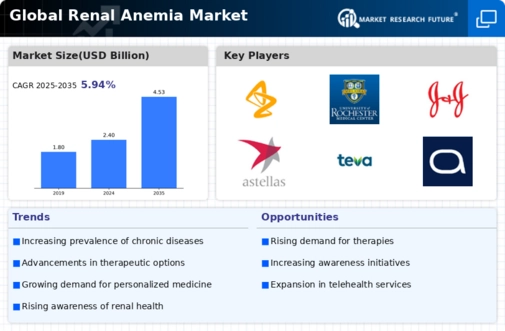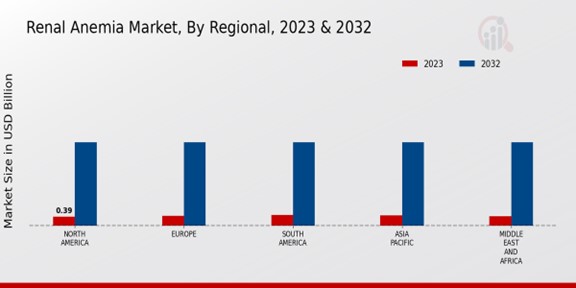Aging Population
The aging population is a significant demographic factor influencing the Global Global Renal Anemia Market Industry. As individuals age, the risk of developing chronic diseases, including CKD and renal anemia, increases. The World Health Organization projects that by 2030, the global population aged 60 years and older will reach 1.4 billion. This demographic shift is likely to result in a higher prevalence of renal anemia, thereby driving demand for effective treatments. Consequently, the market is expected to expand, reflecting the need for tailored therapies that address the unique challenges faced by older patients suffering from renal anemia.
Market Growth Projections
The Global Global Renal Anemia Market Industry is projected to experience substantial growth over the next decade. With an estimated market value of 2.4 USD Billion in 2024, it is expected to reach 4.53 USD Billion by 2035. This growth trajectory indicates a compound annual growth rate (CAGR) of 5.95% from 2025 to 2035. The increasing prevalence of chronic kidney disease, advancements in treatment options, and supportive regulatory environments are likely to contribute to this upward trend. As the market evolves, stakeholders must remain vigilant to emerging trends and adapt strategies accordingly.
Advancements in Treatment Modalities
Innovations in treatment modalities for renal anemia are significantly influencing the Global Global Renal Anemia Market Industry. The introduction of novel erythropoiesis-stimulating agents (ESAs) and iron supplementation therapies has transformed patient management. These advancements not only improve hemoglobin levels but also enhance patients' quality of life. The market is expected to grow to 4.53 USD Billion by 2035, reflecting the increasing adoption of these therapies. Furthermore, the development of biosimilars is likely to provide cost-effective alternatives, thereby expanding access to treatment and potentially increasing market penetration.
Growing Awareness and Screening Programs
There is a notable increase in awareness regarding renal anemia and its association with chronic kidney disease, which is driving the Global Global Renal Anemia Market Industry. Public health initiatives and screening programs are being implemented globally to identify at-risk populations early. For instance, campaigns aimed at educating patients about the symptoms of renal anemia are gaining traction. This heightened awareness is likely to lead to earlier diagnosis and treatment, thereby increasing the demand for therapeutic options. As a result, the market is poised for growth, with a projected CAGR of 5.95% from 2025 to 2035, indicating a robust future for renal anemia management.
Rising Prevalence of Chronic Kidney Disease
The increasing incidence of chronic kidney disease (CKD) is a primary driver of the Global Global Renal Anemia Market Industry. As CKD progresses, it often leads to renal anemia due to reduced erythropoietin production. According to health statistics, approximately 10 percent of the global population is affected by CKD, and this number is expected to rise. This growing patient population necessitates effective treatment options, contributing to the market's projected value of 2.4 USD Billion in 2024. The demand for therapies targeting renal anemia is likely to escalate as healthcare systems strive to manage the complications associated with CKD.
Regulatory Support and Reimbursement Policies
Regulatory support and favorable reimbursement policies are crucial drivers of the Global Global Renal Anemia Market Industry. Governments and health authorities are increasingly recognizing the importance of managing renal anemia as part of comprehensive CKD care. This recognition has led to the establishment of reimbursement frameworks that facilitate patient access to essential therapies. For instance, certain countries have implemented policies that cover the costs of ESAs and iron supplements for patients with renal anemia. Such initiatives are likely to enhance treatment adherence and improve patient outcomes, thereby fostering market growth.




















